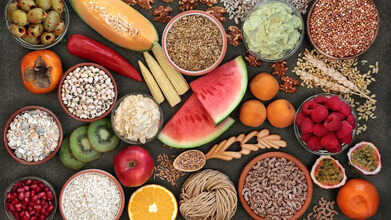- Health Conditions A-Z
- Health & Wellness
- Nutrition
- Fitness
- Health News
- Ayurveda
- Videos
- Medicine A-Z
- Parenting
- Web Stories
Can Vitamin D Cure COVID-19?

Credits: Canva
Vitamin D is one of the essentials for strong bones, but what many may not know is that its impact on immune system is also as important.
But, could it also play a role in lowering your risk of contracting or developing severe COVID-19?
How vitamin D helps with immune system
Vitamin D regulates the body's response and reduces harmful inflammation. Research has proven that it enhances the function of T cells and macrophages—immune cells. These cells are known to combat pathogens effectively.
Low vitamin D levels are also linked to an increased susceptibility to respiratory infections like tuberculosis, asthma, and chronic obstructive pulmonary disease (COPD). Whereas sufficient vitamin D is known to promote a better lung health.
A study that analyzed 11,321 participants across 14 countries showed that supplementing with vitamin D reduced the risk of acute respiratory infections by 12%, with the most significant benefit seen in those who were deficient.
So, will it also work and protect against COVID-19?
Reducing Respiratory Risks: Vitamin D supplementation is known to bolster immune defense, which could mitigate the severity of respiratory infections, including those caused by SARS-CoV-2.
Cytokine Storm Prevention: Vitamin D may help regulate cytokine activity. These are proteins that are essential for the immune system. A "cytokine storm," that happens due to excessive pro-inflammatory cytokine release, is a hallmark of severe COVID-19. It is seen and has been analyzed in studies that those with COVID-19 produce these proteins that lead to a "cytokine storm", which is immune system's natural response. This has also been seen in complications like acute respiratory distress syndrome (ARDS). Studies have found that vitamin D deficiency could exacerbate these immune responses, while supplementation might help counter them.
At this point, there are clincal trials, which are investigating the effects of vitamin D supplementation (dosages up to 200,000 IU) in people with COVID-19.
Who’s Most at Risk of Vitamin D Deficiency?
Vitamin D deficiency is widespread, especially among:
- Older adults are most vulnerable to severe COVID-19 outcomes.
- People who are not often exposed to sun, or people with darker complexion, as their body produces less vitamin D naturally.
- Those who are overweight or have issues with weight management may also have the risk of being vitamin D deficient, as it throws off the body's natural vitamin D metabolism.
What is healthy and what is not?
Too much or too little of anything is not good for your health. Thus, there are levels of how much vitamin D should one maintain. Maintaining vitamin D levels between 30–60 ng/mL is ideal for immune health, and is accepted by most healthcare professionals too. For many, a daily dose of 1,000–4,000 IU is sufficient, but individuals with deficiencies may require higher amounts under medical supervision.
Supplementation, when combined with other preventive measures like vaccination, proper hygiene, and mask-wearing, can enhance overall immunity.
Best Sources of Vitamin D
As per the British Heart Foundation: The best food sources of vitamin D are oily fish, including salmon, mackerel, and sardines. Other sources include egg yolks, red meat, and liver. Vitamin D is added to some foods too, including breakfast cereals, plant milks and fat spreads. Check information on-pack to see if this applies to the products you buy.
Drinking Energy Drinks Often? Your Heart And Brain May Pay The Price

Credits: Canva
Energy drinks have become a common pick-me-up, marketed as quick fixes for sharper focus, improved alertness, and instant energy. Whether you are working late or driving for hours, grabbing a can may feel like the easiest way to stay awake. Yet once that caffeine rush fades, what lasting effects does it leave on your heart, brain, and sleep?
The FDA has received several reports connecting energy drink intake to deaths and serious side effects such as spikes in blood pressure, seizures, and irregular heart rhythms. Many of these incidents required hospital treatment.
Between 2022 and 2023, America’s Poison Centers recorded a 24.2% rise in cases of children and teenagers under 20 being exposed to energy drinks. Worryingly, around 78% of these were accidental, most youngsters did not realize how much caffeine they were consuming or even that their drink contained it.
How Energy Drinks Can Overstimulate Your Heart
Studies have shown that energy drinks can disrupt normal heart rhythm. People who consume them often experience higher blood pressure and irregular heart activity that can last for several hours, which may increase the chance of dangerous arrhythmias.
Caffeine stimulates the sympathetic nervous system, raising heart rate and blood pressure. But unlike coffee, energy drinks combine caffeine with other stimulants such as guarana, taurine, and L-carnitine, which amplify caffeine’s impact, according to researchers at Jefferson Health.
They also note that one can of an energy drink may contain far more caffeine than a standard 8-ounce cup of coffee. The FDA generally considers up to 400 milligrams of caffeine a day to be safe for healthy adults with no heart problems.
Although experts points out that the caffeine difference between coffee and energy drinks may not appear large, labels can be misleading. A cup of coffee contains about 90 mg of caffeine, while energy drinks can range from 100 to 350 mg, sometimes even more when a single can holds multiple servings. Reading labels carefully helps you understand how much caffeine you are really consuming.
Energy Drinks Contain Excess Calories
Along with caffeine, these drinks are often loaded with sugar and calories. Many specialty coffees, packed with syrups, whipped cream, and heavy dairy, fall into the same category. Regularly consuming such beverages increases the risk of weight gain, obesity, and type 2 diabetes, all of which harm heart health.
Dr. Reginald Ho, a cardiologist, explains that over time, this pattern can lead to high blood pressure, rapid heartbeat, and other cardiovascular diseases.
Energy Drinks Can Lead to Stroke Issues
Energy drinks may also raise the risk of stroke. A stroke is often described as a “heart attack in the brain.” One condition linked to these drinks is reversible cerebral vasoconstriction syndrome (RCVS), which involves sudden spasms in the brain’s blood vessels that can either restrict blood flow or cause bleeding, as noted by the Cleveland Clinic.
Caffeine blocks adenosine, the chemical that helps the brain relax, so even when you feel tired, your mind remains overstimulated. This disruption affects your sleep cycle and can cause poor memory, low concentration, mood swings, anxiety, and even depression.
Can You Mix Energy Drinks With Alcohol?
Health experts have repeatedly warned against mixing alcohol with energy drinks. The FDA has stated that adding caffeine to alcohol makes for an “unsafe additive.”
Caffeine’s stimulant effect masks alcohol’s depressant properties, allowing people to drink more without feeling its sedative impact. This can lead to misjudging one’s level of intoxication and even driving while impaired.
While energy drinks may promise a quick fix for fatigue, their risks to the heart, brain, and sleep are real. Choosing natural ways to stay energized, through rest, hydration, and balanced nutrition, is far better for long-term health.
Blue Matcha: The Popular Superdrink That Claims To Boost Health—Does It Really Work?

Credits: Gemini
You have probably heard of green matcha, the bright green tea powder packed with antioxidants and health benefits. But have you come across its strikingly blue counterpart, known as blue matcha? This trendy ingredient — a vivid blue powder — has been popping up on social media in everything from smoothies to cocktails. While blue matcha doesn’t offer the exact same benefits as green matcha, this indigo-hued powder could lift your mood in other ways. So, is blue matcha a superdrink or just a passing health trend? Let’s break it down.
What is Blue Matcha?
Blue matcha comes from the flower of the butterfly pea plant. According to the Cleveland Clinic, “Blue matcha is usually found in powdered form, but sometimes it’s sold as a tea to brew,” explains Romito. “It’s quite different from green matcha, but because it’s consumed in a similar way, that’s likely how it got the matcha name.” Blue matcha also offers a visual perk, making it a favorite in drinks and cocktails. “It’s a chameleon in a cup,” Romito says. “When its antioxidants mix with acidic ingredients like lemonade, it can shift from blue to purple or even pink.”
Health Benefits of Blue Matcha
While it’s fun to play with in drinks, blue matcha does have some potential health perks, Romito notes, according to the Cleveland Clinic:
It’s caffeine-free
Green matcha is loaded with caffeine, making it perfect for a morning boost. Blue matcha, however, has no caffeine. “This is ideal if you avoid caffeine or are sensitive to it,” Romito points out.
It’s rich in anthocyanins
Anthocyanins are the pigments that give foods like cherries, pomegranates, eggplants, and red cabbage their deep blue or purple color. While research is ongoing, these antioxidants may help with:
- Lowering blood pressure
- Reducing the risk of heart disease
- Protecting against neurological conditions
- Slowing cancer growth
“Blue matcha works like any other food with these antioxidants,” Romito emphasizes. “It doesn’t give you more benefits than eating blueberries or purple sweet potatoes. It’s best to include a variety of blue and purple foods in your diet.”
Blue Matcha: Potential Risks or Side Effects
Overall, blue matcha appears safe for most people. Regarding allergies, registered dietitian Natalie Romito, RD, LD, advises that anyone allergic to flowers should start with small amounts to see how their body reacts. She also cautions against overdoing it.
“Too much of anything isn’t good,” Romito says. “Stick to about one serving of blue matcha a day. If it causes nausea or digestive issues, your body might not tolerate it well. In that case, you can rely on other blue and purple foods to get the same antioxidants.”
Adding blue matcha to coffee, tea, cocktails, and other foods can make them more visually appealing. While it does have some health benefits, more research is needed to fully understand its potential.
“If you enjoy blue matcha, that’s great,” Romito concludes. “But don’t replace other blue and purple foods with it. Keep eating blueberries, beets, and grapes. Blue matcha can be a fun addition, but it shouldn’t replace the nutritional value of other foods.”
Is The Viral Wellness Trend ‘Fibremaxxing’ Helping Or Harming Your Gut?

Credits: CANVA
Tiktok fibremaxxing wellness trend: There is no shortage of wellness trends online that claim to transform your health, but a new one has taken over social media with a focus on gut health. It’s called “fibremaxxing,” and its premise is simple: eat more fibre to improve digestion, metabolism, immunity, and lower the risk of disease. On TikTok and Instagram, the trend often appears as colourful lentil bowls, chia puddings, and smoothies loaded with leafy greens and flaxseeds. But how much of this viral trend is actually backed by science?
The idea of increasing both soluble and insoluble fibre isn’t new, yet fibremaxxing has made it trendy again—and this time, for good reason. Fibre is vital to everyday health, supporting everything from steady blood sugar to regular bowel movements. Here’s what experts say about this growing movement and why fibre truly matters.
What Is Fibremaxxing?
Fibremaxxing is a social media movement that encourages people to boost their fibre intake by adding more fruits, vegetables, legumes, and whole grains to every meal. The goal is to improve digestion, promote fullness, and support long-term health. According to Dr. Urvi Shah, a board-certified hematologist-oncologist and physician at Memorial Sloan Kettering Cancer Center, the concept behind fibremaxxing is largely rooted in scientific evidence. Dr. Shah, who is leading multiple studies on high-fibre plant-based diets, notes that the approach aligns well with established nutrition research.
Is ‘Fibremaxxing’ Good Or Bad For Your Gut?
High-fibre diets are consistently linked to a wide range of health benefits, from lowering the risk of heart disease, diabetes, and colon cancer to aiding weight control and gut function. That’s why Dr. Shah believes fibremaxxing gets several aspects right.
She explains that including a wide variety of plant-based, high-fibre foods is essential because “different fibre types feed different microbes.” A diverse diet helps nurture a balanced microbiome. She adds that the trend’s emphasis on whole foods rather than processed or fibre-enriched items is a major plus. “Whole plants provide fibre, polyphenols, and micronutrients that work together to support the gut,” she says. Prebiotic-rich foods also help shape a healthier microbiota and increase the production of beneficial short-chain fatty acids like butyrate, which has “anti-inflammatory and anti-cancer effects.”
Simply put, upping your fibre intake through natural, unprocessed foods, rather than supplements, can make a real difference to gut health.
What’s The Daily Recommended Amount of Fibre Intake?
Experts suggest that adults should consume between 25 and 30 grams of fibre each day. Men typically require more (around 38 grams), while women need about 25 grams. These numbers can vary depending on age, sex, and calorie intake, but a general guideline is 14 grams of fibre for every 1,000 calories eaten, according to Harvard Health.
How To Add Fibre To Your Diet?
Plant-based foods are the easiest way to increase your fibre intake, this could mean starting your morning with oats or simply adding more vegetables to your meals. Dietitian Laura Tilt notes that several everyday foods are surprisingly high in fibre:
- Rolled porridge oats – 4.5g per 50g (half cup)
- Canned chickpeas – 7g per half can
- Seeded bread – 5g per two slices
- Canned lentils – 6g per half can
- Frozen peas – 4.5g per 80g (3 tbsp)
- Frozen raspberries – 5.5g per 80g (3 tbsp)
- Wholemeal pasta – 6.5g per 75g serving
- Dried apricots – 3g per 3–4 pieces
- Reduced salt/sugar baked beans – 7.5g per half can
- Mixed milled seeds (flax, pumpkin, chia) – 4.5g per 25g
Is Fibremaxxing Helpful?
There’s no doubt fibre plays an essential role in maintaining good health. But like any nutrient, too much of it can cause problems if not balanced properly. A sudden surge in fibre intake without enough water can lead to bloating, gas, constipation, dehydration, or even trigger IBS symptoms. Over-focusing on fibre might also cause you to overlook other nutrients your body needs. The key is moderation, fibre is beneficial, but it works best as part of a balanced, varied diet.
© 2024 Bennett, Coleman & Company Limited

